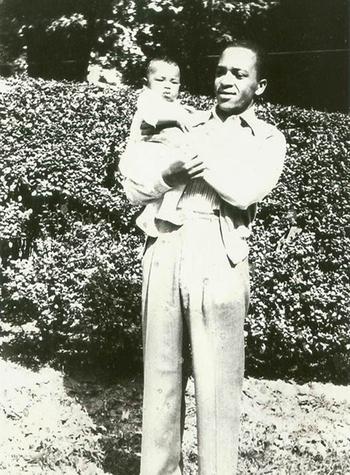
Members of the 555th (Triple Nickel) Parachute Infantry Battalion are briefed before takeoff from Fort Dix, N.J., in 1947. (National Archives and Records Administration/TNS)
(Tribune News Service) — On the day that the United States stunned the world by dropping an atomic bomb on Hiroshima, a young Black man from the Main Line area of Philadelphia died in obscurity in a remote Oregon forest, the end of a brief military career that became enmeshed in some of the most significant currents of U.S. and world history.
The story of paratrooper Malvin L. Brown was a saga of racial prejudice, secrecy, a cosmic discovery in the annals of atmospheric science, tragedy, and, ultimately, a 70-year mystery.
Brown has just received a high honor posthumously: The government officially changed the name of what was “Negro Ridge,” in the Umpqua National Forest in southern Oregon, to Malvin L. Brown Ridge.
“I am thrilled,” said Robert Bartlett, an Army veteran and sociologist who has devoted several years to researching Brown’s unit, the 555th Parachute Infantry Battalion, and who was instrumental in the renaming. He was among those informed earlier this month of the decision by the U.S. Board of Geographic Names.
The ridge, 3.4 miles long, sprawling across 2,800 acres, and rising to 3,500 feet, is close to where Brown died during a firefighting parachute jump Aug. 6, 1945, on a top-secret mission that remains a little-known chapter in the annals of war.
Balloon bombs
Mysterious objects were appearing in the sky, and the government was resolutely mum about them.
These objects weren’t from China or outer space, but Japan, and in this case government secrecy proved deadly.
They were incendiary balloon bombs, the canopies patched together by teenagers, and launched into the potent upper-air west-to-east jet-stream winds that only the Japanese knew about. U.S. and German bombers later learned about them the hard way when the winds blew their bombs off target and dangerously consumed their fuel supplies.
They were discovered in the 1920s by pioneering atmospheric researcher Wasaburo Oishi, who tried to share his findings with the world by publishing them in Esperanto, the universal scientific language. The West ignored him.
The Japanese balloon campaign aimed to ignite widespread forest fires in the Pacific Northwest and incite panic. Neither Oishi nor anyone else appreciated the chaos of those winds, and the balloons landed everywhere from Canada to Texas.
The balloons prompted the Army to assign a special group of paratroopers, the 555th, or “Triple Nickles,” to become firefighting “smoke jumpers.”
Triple Nickles
The 300 members of the Triple Nickles had one trait in common: They were Black. Historically, Black soldiers had such roles as cooks and dishwashers. These were the nation’s first Black paratroopers.
But the U.S. military feared that their presence in Europe might stir racial animosities.
“They wanted to go fight Hitler in Europe, and ended up getting sent to Pendleton, Ore.,” said Eric Heinmann, another veteran instrumental in the ridge-renaming campaign.
From Pendleton, said Bartlett, active in both the 555th Parachute Infantry and National Smokejumpers Associations, “they thought they were going to Japan.” Instead, “they gave up all their military gear for picks and shovels.” Ironically, he said, he found no evidence that any of the fires they fought were balloon-related.
Their mission in the Pacific Northwest was top secret, and that secrecy would have a deadly side effect.

Malvin Brown holding who is believed to be his baby daughter. (U.S. Army)
Tragedy in the woods
In May 1945, unaware of the danger, six people on a Sunday school picnic in the Oregon woods, including the pregnant wife of a local minister, were killed when a bomb attached to a fallen balloon exploded. They were the only World War II civilian casualties on U.S. soil.
Two months later, Malvin Brown died during a jump in the Umpqua National Forest. The death certificate listed the cause as a skull fracture.
Juanita Hays, Brown’s only surviving relative, said the family knew nothing of Brown’s mission and didn’t learn about it until several years ago.
About Malvin Brown
Hays, 81, who works as a receptionist at the Zion Baptist Temple in Ardmore, Pa., recalled that she; Brown, who was her uncle; and other relatives lived in the only twin home on a block of rowhouses in the Haverford section of Lower Merion Township in a neighborhood where racial strife was a foreign concept.
Brown, who had dropped out of Lower Merion High School at age 16, according to school records, joined the Army in November 1942. Hays’ late older sister, Vernell Brown, had recalled in a 2015 interview that when Brown came home on leave with his boot camp-sculpted body, everyone made a fuss over him.
Hays, just 3 years old when her uncle was killed, said he was remembered as a “really nice guy, easy to get along with.”
Vernell Brown had said in an interview: “When he went in the service, it didn’t surprise us at all. He was very compassionate, and he liked people.”
Not much of family lore about Malvin Brown has survived, Hays said, adding that he and his wife were divorced and that their daughter was deceased.
Even less was known about his burial. A document shows that a payment was made to a Bryn Mawr funeral home, but despite earlier efforts by the Triple Nickles and the affiliated Smokejumpers, his grave remained undiscovered until 2015, when it was located through the efforts of The Inquirer.
Although the veils of secrecy obscuring the Triple Nickles’ mission in the Northwest have long been peeled away, the “shocker,” said Bartlett, is “how little people know of this story.”
©2023 The Philadelphia Inquirer, LLC.
Visit at inquirer.com.
Distributed by Tribune Content Agency, LLC.